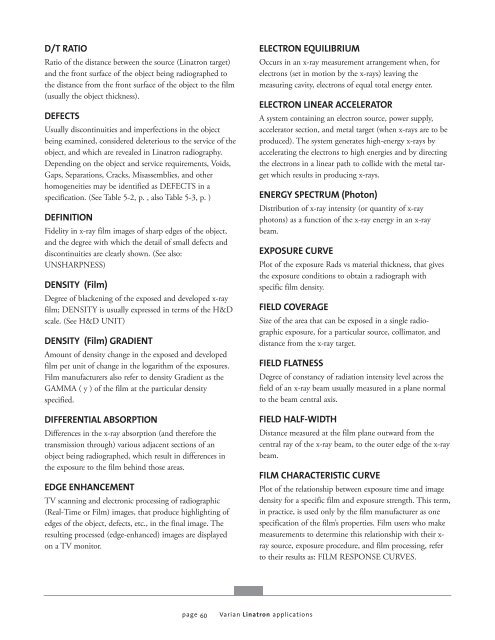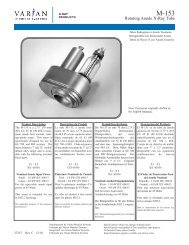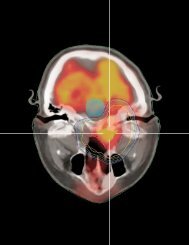Varian Linatron High-Energy X-ray Applications 2007
Varian Linatron High-Energy X-ray Applications 2007
Varian Linatron High-Energy X-ray Applications 2007
You also want an ePaper? Increase the reach of your titles
YUMPU automatically turns print PDFs into web optimized ePapers that Google loves.
D/T RATIO<br />
Ratio of the distance between the source (<strong>Linatron</strong> target)<br />
and the front surface of the object being radiographed to<br />
the distance from the front surface of the object to the film<br />
(usually the object thickness).<br />
DEFECTS<br />
Usually discontinuities and imperfections in the object<br />
being examined, considered deleterious to the service of the<br />
object, and which are revealed in <strong>Linatron</strong> radiography.<br />
Depending on the object and service requirements, Voids,<br />
Gaps, Separations, Cracks, Misassemblies, and other<br />
homogeneities may be identified as DEFECTS in a<br />
specification. (See Table 5-2, p. , also Table 5-3, p. )<br />
DEFINITION<br />
Fidelity in x-<strong>ray</strong> film images of sharp edges of the object,<br />
and the degree with which the detail of small defects and<br />
discontinuities are clearly shown. (See also:<br />
UNSHARPNESS)<br />
DENSITY (Film)<br />
Degree of blackening of the exposed and developed x-<strong>ray</strong><br />
film; DENSITY is usually expressed in terms of the H&D<br />
scale. (See H&D UNIT)<br />
DENSITY (Film) GRADIENT<br />
Amount of density change in the exposed and developed<br />
film per unit of change in the logarithm of the exposures.<br />
Film manufacturers also refer to density Gradient as the<br />
GAMMA ( y ) of the film at the particular density<br />
specified.<br />
DIFFERENTIAL ABSORPTION<br />
Differences in the x-<strong>ray</strong> absorption (and therefore the<br />
transmission through) various adjacent sections of an<br />
object being radiographed, which result in differences in<br />
the exposure to the film behind those areas.<br />
EDGE ENHANCEMENT<br />
TV scanning and electronic processing of radiographic<br />
(Real-Time or Film) images, that produce highlighting of<br />
edges of the object, defects, etc., in the final image. The<br />
resulting processed (edge-enhanced) images are displayed<br />
on a TV monitor.<br />
page 60<br />
ELECTRON EQUILIBRIUM<br />
Occurs in an x-<strong>ray</strong> measurement arrangement when, for<br />
electrons (set in motion by the x-<strong>ray</strong>s) leaving the<br />
measuring cavity, electrons of equal total energy enter.<br />
ELECTRON LINEAR ACCELERATOR<br />
A system containing an electron source, power supply,<br />
accelerator section, and metal target (when x-<strong>ray</strong>s are to be<br />
produced). The system generates high-energy x-<strong>ray</strong>s by<br />
accelerating the electrons to high energies and by directing<br />
the electrons in a linear path to collide with the metal target<br />
which results in producing x-<strong>ray</strong>s.<br />
ENERGY SPECTRUM (Photon)<br />
Distribution of x-<strong>ray</strong> intensity (or quantity of x-<strong>ray</strong><br />
photons) as a function of the x-<strong>ray</strong> energy in an x-<strong>ray</strong><br />
beam.<br />
EXPOSURE CURVE<br />
Plot of the exposure Rads vs material thickness, that gives<br />
the exposure conditions to obtain a radiograph with<br />
specific film density.<br />
FIELD COVERAGE<br />
Size of the area that can be exposed in a single radiographic<br />
exposure, for a particular source, collimator, and<br />
distance from the x-<strong>ray</strong> target.<br />
FIELD FLATNESS<br />
Degree of constancy of radiation intensity level across the<br />
field of an x-<strong>ray</strong> beam usually measured in a plane normal<br />
to the beam central axis.<br />
FIELD HALF-WIDTH<br />
Distance measured at the film plane outward from the<br />
central <strong>ray</strong> of the x-<strong>ray</strong> beam, to the outer edge of the x-<strong>ray</strong><br />
beam.<br />
FILM CHARACTERISTIC CURVE<br />
Plot of the relationship between exposure time and image<br />
density for a specific film and exposure strength. This term,<br />
in practice, is used only by the film manufacturer as one<br />
specification of the film’s properties. Film users who make<br />
measurements to determine this relationship with their x<strong>ray</strong><br />
source, exposure procedure, and film processing, refer<br />
to their results as: FILM RESPONSE CURVES.<br />
<strong>Varian</strong> <strong>Linatron</strong> applications











![[MSDS 126] Dow Corning 200 Fluid, 5 CST Part Number ... - Varian](https://img.yumpu.com/5104917/1/190x245/msds-126-dow-corning-200-fluid-5-cst-part-number-varian.jpg?quality=85)





